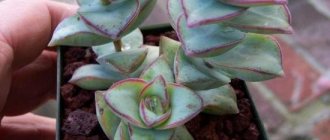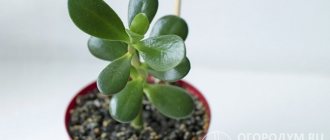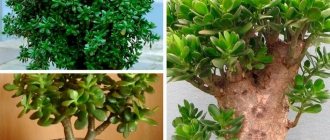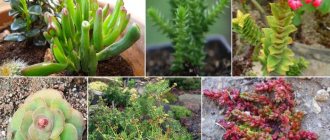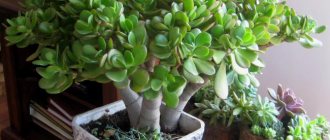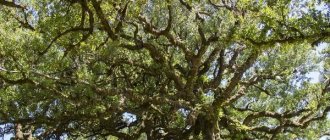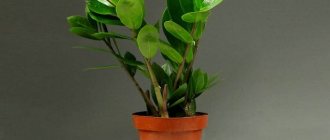Process Features
Before planting a shoot, you need to acquire an adult tree, take into account the subtleties of choosing a container, the condition of the plant, and buy or prepare your own substrate. Only after this can you proceed to the process of plant propagation.
Age and condition of the tree
The optimal age for collecting cuttings or leaves is 3-4 years, but no less.
The indoor flower should be strong and healthy, without signs of disease or the presence of pest larvae. The best option is when there are aerial roots on the cuttings and leaves. This indicates that the Crassula seedling will quickly and successfully take root.
Choosing a pot
The container for the shoot is selected based on the size of the mother bush. Since the root system of the fat plant does not spread deep, but branches out to the sides, the diameter of the pot should correspond to the crown of the money tree. This is the case if you initially plant a leaf or cutting directly into a permanent container. If you are planning a further transplant, you can take a plastic glass - for the first time it is quite enough.
Soil selection
Crassula prefers loose and light soil, otherwise the plant will die. This is especially important during propagation, since the root system has not yet been formed. Consequently, it will be difficult for young roots to break through heavy soil.
If possible, purchase a soil mixture intended for succulents at a garden store or prepare the substrate at home. Choose one of the options:
- soil from the garden - 4 parts, special baking powder (or vermiculite, river sand, peat) - 1-2 parts, depending on the type of soil;
- turf soil and sand – 1 part each, leaf soil – 2 parts.
Do not forget to disinfect the soil taken from the garden before mixing the components. This is done in different ways - roasted in the oven, doused with boiling water, and poured with a light pink solution of potassium permanganate.
What capacity will you need?
To plant a money tree, it is recommended to choose shallow, wide pots, the diameter of which should approximately correspond to the size of the plant’s crown (how to form a crown?). The material from which the pot is made is not of fundamental importance; both clay or ceramic pots and plastic ones are suitable for Crassula.
To root the cutting, you need to choose a small container ; even an ordinary plastic cup will do, since after a year the young plant will have to be replanted in any case. In a separate article, we discussed in detail the issue of choosing a pot for Crassula.
Propagation of Crassula by cuttings
Cuttings are the best method of propagating a money tree, especially compared to seed planting. In the second case, the process is delayed for 1-2 years, and it is problematic to collect planting material yourself.
The main advantage of cuttings is that the plants grow completely identical to the mother Crassula.
How to take a shoot correctly?
For propagation, cuttings of 2 types are used - apical and stem. The first ones can be taken when forming the crown of the tree, but for the second ones you will have to cut the stem. To ensure that the shoot meets the standards and requirements of planting material, pay attention to the following indicators:
- time of year - spring (March-April) is considered the most favorable, since it is at this time that the root system will grow at an accelerated pace;
- cutting size – minimum 10 cm, maximum 15 cm;
- number of leaves on the stem – 3 pairs;
- nodes – 3-4 pcs.
The cutting procedure is carried out as follows:
- Choose the strongest and most developed shoots.
- Using a utility knife, make a cut just below the knot. It is advisable to cut at a slight angle.
Preparation
Preparatory activities involve the following actions, carried out immediately after cutting the cuttings:
- Treat the cut area with any antiseptic, but it is better to powder it with powdered activated carbon.
- Place the cuttings on a woven towel and let dry.
- This usually takes about 24-48 hours.
- If possible, provide air access.
- Plant dry elements using the chosen method.
Rooting in the ground
The procedure for rooting a shoot in the soil is simple, but it is important to follow some rules. For example, you need to place pebbles or expanded clay at the bottom of the pot, which will create a drainage system. If this is not done, then from excess moisture, the money tree will rot.
How to plant cuttings correctly:
- Place drainage on the bottom of the pot, in a layer of about 2-3 cm.
- Fill a little more than half the pot with substrate. Make a recess for the process. Insert the cutting. If you want to use growth stimulants, soak a cotton pad in the preparation and treat the cut area with it. To do this, you can buy Epin and dilute 1 ml in 2 liters of water.
- Sprinkle fine river sand on top, which will prevent mold from forming and will maintain an optimal level of humidity in the soil.
- Lightly compact and moisten the substrate.
- Cover the cuttings with a glass jar (or use cut plastic bottles).
Be sure to remove the cover daily to allow oxygen to flow. As soon as the plant begins to grow, remove the jars completely.
Rooting in water
Making cuttings in water is the simplest procedure, since you do not need to make or buy a substrate or strictly monitor the level of humidity.
Unlike ground planting, the first roots appear in just 7-10 days (in the first case, the time needed is almost 2 times longer). How to propagate by cuttings in water:
- Prepare the container. Usually for this they take a plastic glass, a cut bottle or a small container.
- Pour enough warm, settled water to cover about 4 cm of the stem. But the main thing is that the kidney must be in water.
- Place the shoot.
Transplantation is carried out when the length of the roots reaches 5 cm. This will be clearly visible through a transparent container (as opposed to cuttings into the ground).
Rules for caring for cuttings after rooting
The main indicator of the success of money tree propagation is the formation of the root system. But this is noticeable only when the stalk is in a glass of water. If you immediately planted it in a pot with soil, pay attention to the green mass - the top should rise up and the leaves should grow.
Regardless of the rooting method, proceed as follows:
- Place the plant in a bright place, for example, on a windowsill;
- do not expose to direct sunlight;
- for the first 6-8 months it is forbidden to apply fertilizers;
- water the cuttings so that the liquid does not stagnate;
- for watering and replacing water in a glass, use only settled and warm water;
- to stimulate the growth of the cutting, add 0.5 tablets of succinic acid per 100-125 ml of water to the water with the shoot or for watering the soil;
- at the germination stage, you can fertilize 1 time with one of the preparations - Agricola Ava or Fusco Flower Happiness (they are intended for succulents and cacti), the dosage depends on the instructions.
Reproduction by leaves
This is also a simple and quick way to propagate a succulent. Used when cuttings are not possible. As in the previous case, you need to act step by step and in strict compliance with the requirements and rules.
How to choose the right sheet?
It is important to select high-quality planting material - the speed of rooting and the process of plant development depend on this.
What should be the leaf for planting:
- surface – shiny;
- color – plain, tinted;
- dimensions – volumetric;
- structure – dense;
- condition – no breaks/cuts, signs of disease or eating by insects;
- the optimal cutting location is the middle of the shoot on the mother bush;
- age – the tree must be at least 3-4 years old.
It is very good if aerial roots are formed on the leaves. Dried, wilted and damaged leaves are unacceptable for rooting.
Rooting in soil
The first thing a gardener does is prepare the soil and pot. A short but wide glass, for example, a yogurt cup, is suitable for the leaf. What to do next:
- Place expanded clay stones (small) on the bottom. Sprinkle substrate on top. After it 1 tbsp. l. crushed charcoal. Moisten with a spray bottle.
- Cut the leaf, pollinate the broken area with activated carbon, turmeric, or treat it with any garden antiseptic.
- Let the leaf dry, then make a small depression in the soil and insert the cut side of the leaf into the ground. Make a retainer from any plastic lid. To do this, cut the middle so that a leaf of the money tree fits into the gap. Lock the element.
Features that are important to pay attention to:
- instead of a lid, you can use a toothpick or a match as a support;
- water once every 2 days and in small doses, since unlike a stem on a cutting, a leaf is more susceptible to rotting;
- when shoots form near the leaf, remove the clamp;
- 1-2 leaves or several can be planted in one pot at a distance of 4-5 cm from each other;
- deepen the sheet by 1/3;
- Before the shoots appear, it is advisable to cover the container with a jar or plastic wrap.
To see how experienced gardeners root leaves in the substrate, watch our video:
Rooting in water
Not exactly a recommended method for leaf propagation, as the leaf is subject to rotting.
Despite this, it is possible to control this process. The planting procedure is completely identical to rooting a cutting in water, but there are some features:
- Insert the leaf into the water.
- Change the water once every 2-3 days.
- As soon as you see roots, transplant the plant into soil mixture for permanent cultivation.
- When replanting, do not bury the bush - only the roots should be in the ground.
- Immediately after transplanting, cover the fat plant with a jar for 2-3 days.
Rooting on moss
An unusual method of rooting money tree leaves, but no less effective.
The main advantage is that the roots will develop in a natural environment, so the risk of rotting is reduced. For planting, use forest moss or sphagnum (sold in a flower shop). The landing process is as follows:
- Form a piece of moss of the required size (for the container).
- Treat it with a specialized anti-fly product (the range is very rich) and always with a light pink solution of potassium permanganate for disinfection. This is especially true for moss that is collected in the forest.
- Place the moss in a container and moisten it with a spray bottle so that water does not flow out of it.
- Insert a crassula leaf.
- Moisten the moss every day, and when the root appears, immediately transplant it into the substrate.
Where should the money tree be located in the house?
Crassula loves the sun and bright light, but it should not be placed on southern windowsills, since direct rays of the sun passing through the glass will cause numerous burns on the leaves.
On the south side of the house, Crassula can only be placed on a table by the window, screening the plant with a light tulle curtain.
The optimal placement location is the south-eastern side of the room. But the fat plant feels quite good on south-west windows. However, on hot days, Crassula needs to be shielded from direct light.
In addition to good lighting, the money tree loves fresh air and cleanliness in the room . If there is a lot of dust in the room, the plant will often get sick. The room should be well ventilated to avoid air stagnation, but the plants should be positioned so that they are not affected by drafts, which they tolerate as poorly as stuffiness.
How to propagate by seeds?
This method is used extremely rarely, since the process is long and complex. Crassula blooms once every few years, so collecting planting material is problematic. The optimal solution to the problem is to buy store-bought seeds.
If you decide to collect your own seeds, you can speed up the flowering process. Features how to do it:
- use a bush that is at least 5-6 years old;
- transplant the tree into a very spacious pot (wide and not deep);
- in winter, keep the temperature to 14-16 degrees, and in spring and summer always take it outside/balcony;
- do not allow sudden changes in air temperature;
- do not feed from mid-September until the last days of February, that is, during the dormant period (water at this time twice a month and not more often);
- in March, apply fertilizer intended for succulents (or cacti);
- place only on a sunny windowsill, but without direct rays;
- It is useful to wipe and water the plant with succinic acid (1 tablet per 250 ml of water).
When the flower blooms, apply appropriate fertilizer and wait until the flowers fade. This is the time of seed ripening. Collect them and start planting, which involves several stages:
- Disinfect planting material. To do this, prepare a weak solution of potassium permanganate, dip the seeds in it for 15 minutes, then rinse. Do the same with the soil - pour it with a solution of potassium permanganate.
- Place the substrate in a wide but low container (you can use special containers for seedlings). Sprinkle a thin layer of wood ash on top of the soil. Moisten the soil mixture with a spray bottle. Sow the seeds without digging - just on top of the soil.
- Cover loosely with plastic wrap.
Open the created greenhouse every day for ventilation, moisten the soil mixture as it dries, but do this only with a spray bottle. When sprouts appear (and this will happen on days 14-18), remove the cover completely.
When the sprouts reach 2-3 cm, plant them in separate pots, selecting the strongest and most durable elements.
Possible problems and solutions
The money tree is one of the indoor flowers that require a special approach, so when propagating crassula, beginners often make a number of mistakes, which is why the seedlings simply die. To prevent this, use the following recommendations:
| Problem encountered | Why did this happen? | How to fix the error? |
| Weakening and stretching of the plant | Too little light. | Place it on a lighted windowsill and additionally turn on the fluorescent lamps so that the light remains on for 12-14 hours until the seedlings are restored. |
| Yellowing leaves, falling stems | Excess moisture, which causes the root system to rot. | There are several ways to solve the problem:
Be sure to remove any yellowed leaves. |
| Drying out foliage | Insufficient watering. | In this case, you need to moisten the soil abundantly. |
| Formation of dark spots | Fungal diseases that arose due to the fact that disinfection was not carried out before rooting. | You will have to treat with fungicides in accordance with the instructions for the specific drug. |
| Roots do not form for a long time | Lack of lighting, low air temperature. | Provide the bush with light, increase the temperature to +18...+25 degrees. Additionally, add a growth stimulator (Zircon, Epin). |
| The stalk leans to one side | Lack of lighting. | Install lamps and periodically turn the pot with the seedling in different directions. |
| The roots are growing back, but too slowly | Too dense soil. | Be sure to replace the soil mixture with loose substrate. Add peat, sand, etc. to this soil in a 1:1 ratio. |
Never replant a cutting or leaf if the plant is not yet fully established. In this case, it will be difficult for the fat plant to adapt and take root, so the tree will begin to hurt or die.
Description of the plant
Crassula belongs to the Crassula family and has more than 300 species of different sizes and shapes. They are united by fleshy leaves located crosswise along the stem.
In nature, the Crassula lives in the arid regions of Africa. Foliage that accumulates moisture helps it withstand such a climate. Wild varieties of the plant sometimes reach a height of several meters. For home gardening, shorter varieties are used.
Several types of crassula are popular in Russia, but they bear little resemblance to each other.
The most common is Crassula arborescens. This is what is commonly called the money tree.
The plant stretches upward to a height of up to 1.5 meters. Its resemblance to a tree is given by its green-brown stem, similar to a trunk up to 7 cm in diameter with several branches. The leaves are round or ovate with a shiny surface. The outer side is dark green or with a bluish tint. The inner one is reddish. The leaves are up to 8 cm long and up to 5 cm wide.
Crassula reaches its maximum size by 10 years. It also blooms at this age, although this rarely happens at home. The flowers are small, white at first, then turn a little pink.
Crassula is easily propagated at home; there are several planting methods:
- leaves
- cuttings
- seeds
